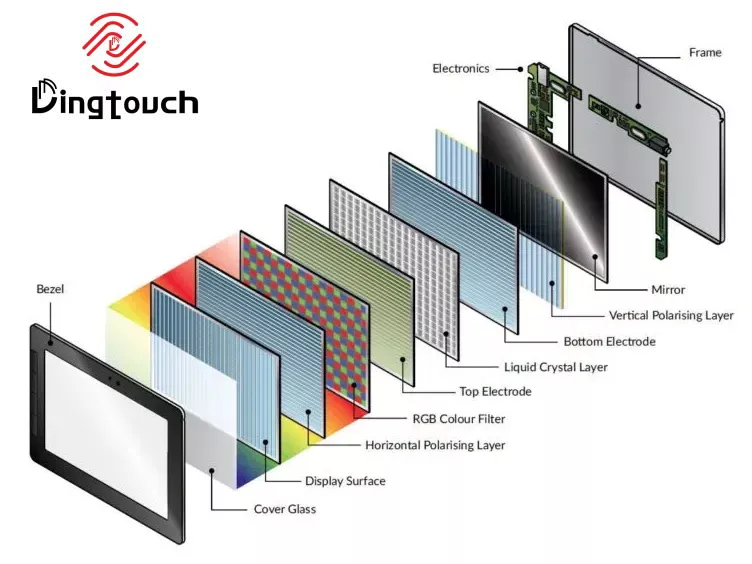News
How Does PLS TFT LCD Technology Enhance Viewing Angles And Color Accuracy?

How Does PLS TFT LCD Technology Enhance Viewing Angles And Color Accuracy?
Content Menu
● What is PLS TFT LCD Display?
● Advantages of PLS TFT LCD Display
● Applications of PLS TFT LCD Display
● Comparison with Other Display Technologies
>> PLS vs. IPS
>> PLS vs. OLED
● Future Trends in PLS TFT LCD Technology
>> Q1. What is the main advantage of PLS TFT LCD displays over traditional TFT display?
>> Q2. Are PLS TFT LCD display energy-efficient?
>> Q3. In which industries are PLS TFT LCD display commonly used?
>> Q4. How do PLS displays compare to OLED display?
>> Q5. What future advancements can we expect in PLS TFT LCD technology?
Introduction
In the realm of display technology, PLS (Plane to Line Switching) TFT (Thin Film Transistor) LCD (Liquid Crystal Display) has emerged as a significant player. This technology is renowned for its superior performance, vibrant color reproduction, and wide viewing angles. In this article, we will delve into the intricacies of PLS TFT LCD display, exploring their technology, applications, advantages, and much more.

What is PLS TFT LCD Display?
PLS TFT LCD display are a type of LCD technology that enhances the traditional TFT LCD by improving the viewing angles and color accuracy. The PLS technology was developed by Samsung and is often compared to IPS (In-Plane Switching) technology. The primary advantage of PLS over conventional TFT LCDs is its ability to provide better color reproduction and wider viewing angles, making it an ideal choice for various applications.
How PLS Technology Works
PLS technology operates by arranging the liquid crystals in a way that allows for better light transmission. This arrangement minimizes light leakage and enhances the display's brightness and color accuracy. The result is a display that can be viewed from wider angles without significant color distortion or loss of brightness.
Advantages of PLS TFT LCD Display
1. Wide Viewing Angles
One of the standout features of PLS TFT LCD display is their wide viewing angles. Users can view the screen from various positions without experiencing color shifts or brightness loss. This characteristic is particularly beneficial in collaborative environments where multiple people need to view the screen simultaneously.
2. Enhanced Color Accuracy
PLS technology offers improved color accuracy compared to traditional TFT display. This enhancement is crucial for applications that require precise color representation, such as graphic design, photography, and video editing.
3. High Brightness Levels
PLS TFT LCD display are known for their high brightness levels, making them suitable for use in brightly lit environments. This feature ensures that the display remains visible even in direct sunlight, which is essential for outdoor applications.
4. Energy Efficiency
PLS display are designed to be energy-efficient, consuming less power than traditional LCD. This efficiency not only reduces operational costs but also contributes to a lower environmental impact.
5. Cost-Effectiveness
While PLS TFT LCD display offer advanced features, they are often more cost-effective than other high-end display technologies like OLED. This affordability makes them an attractive option for manufacturers and consumers alike.
Applications of PLS TFT LCD Display
PLS TFT LCD display find applications across various industries due to their versatility and performance. Here are some notable applications:
1. Consumer Electronics
PLS TFT LCD display are widely used in consumer electronics, including smartphones, tablets, and televisions. Their vibrant colors and wide viewing angles enhance the user experience, making them a popular choice among manufacturers.
2. Automotive Displays
In the automotive industry, PLS TFT LCD display are utilized for dashboard displays, infotainment systems, and rear-seat entertainment. The high brightness and wide viewing angles ensure that information is easily readable in various lighting conditions.
3. Medical Equipment
Medical devices often require displays that provide accurate color representation and high clarity. PLS TFT LCD display are used in medical imaging equipment, patient monitoring systems, and diagnostic devices, where precision is critical.
4. Industrial Applications
In industrial settings, PLS TFT LCD display are employed in control panels, machinery interfaces, and monitoring systems. Their durability and resistance to environmental factors make them suitable for harsh conditions.
5. Digital Signage
PLS TFT LCD display are increasingly used in digital signage applications, such as advertising displays and information kiosks. Their ability to attract attention with vibrant colors and clear images makes them effective for marketing purposes.
Comparison with Other Display Technologies
PLS vs. IPS
While both PLS and IPS technologies aim to provide wide viewing angles and accurate colors, there are some differences. PLS displays generally offer better brightness and are more cost-effective than IPS displays. However, IPS technology is often preferred for its superior color accuracy in professional applications.
PLS vs. OLED
OLED (Organic Light Emitting Diode) displays are known for their deep blacks and high contrast ratios. However, they can be more expensive and may suffer from burn-in issues. PLS TFT LCD displays, on the other hand, provide a good balance of performance and cost, making them suitable for a wider range of applications.
Future Trends in PLS TFT LCD Technology
As technology continues to evolve, PLS TFT LCD display are expected to see advancements in several areas:
1. Higher Resolutions
With the demand for higher resolution display, PLS technology is likely to adapt to support 4K and even 8K resolutions, providing users with sharper images and more detail.
2. Enhanced Color Gamuts
Future PLS display may incorporate wider color gamuts, allowing for even more accurate color reproduction. This enhancement will be particularly beneficial for professional applications in design and media.
3. Flexible Displays
The development of flexible PLS TFT LCD display could open new possibilities for applications in wearable technology and innovative product designs.
Conclusion
PLS TFT LCD display represent a significant advancement in display technology, offering a combination of wide viewing angles, enhanced color accuracy, and energy efficiency. Their versatility makes them suitable for a wide range of applications, from consumer electronics to industrial settings. As technology continues to evolve, we can expect further improvements in PLS displays, solidifying their place in the future of display technology.
Frequently Asked Questions
Q1. What is the main advantage of PLS TFT LCD display over traditional TFT display?
A: The main advantage of PLS TFT LCD display is their wide viewing angles and enhanced color accuracy, which provide a better viewing experience.
Q2. Are PLS TFT LCD display energy-efficient?
A: Yes, PLS TFT LCD display are designed to be energy-efficient, consuming less power compared to traditional LCD.
Q3. In which industries are PLS TFT LCD display commonly used?
A: PLS TFT LCD display are commonly used in consumer electronics, automotive displays, medical equipment, industrial applications, and digital signage.
Q4. How do PLS displays compare to OLED display?
A: While PLS display offer good performance at a lower cost, OLED displays provide deeper blacks and higher contrast ratios but can be more expensive and prone to burn-in issues.
Q5. What future advancements can we expect in PLS TFT LCD technology?
A: Future advancements may include higher resolutions, enhanced color gamuts, and the development of flexible displays for innovative applications.
DINGTouch: Committed to continuous innovation and improvement of product quality to meet customers' high requirements and expectations.
DINGTouch is a manufacturer that provides high quality touch screen panels. Focus on the design, manufacturing and sales of touch screen panels, and are committed to providing customized solutions that satisfy customers.
DINGTouch: In the process of customizing touch screen panels, we focus on close cooperation and communication with customers. Understanding customers' needs and providing customized solutions will meet customers' individual needs. The company's products are favored by customers for their high quality and reliability, and provide them with the best touchscreen panel solutions.
At DINGTOUCH, we are the world's leading touchscreen manufacturer, helping businesses around the world take advantage of this exciting technology. For more information, please visit the home page now.
Find the DINGTouch technical team to achieve the success of your company's new project.
How to choose touch screen customization?
DINGTouch is a company specializing in the R&D and production of touch screen technology, headquartered in Shenzhen, China. As a professional touch screen supplier, DINGTouch is committed to providing high-quality, stable and reliable touch screen products to meet the diverse needs of customers. We continue to carry out technological innovation and product optimization to ensure that its touch screen products have good sensitivity, accuracy and durability.
In addition to the products themselves, we also focus on cooperation and communication with customers, and are committed to providing customized solutions and excellent after-sales services. Through continuous efforts to improve product quality and customer satisfaction, we have established a good reputation in the touchscreen industry and won widespread market recognition.
What DINGTOUCH can do:
• PCAP maximum size 65”
• Multi-touch (Touch screen can be customized to your needs.)
• Optical bonding service/air bonding
• LCD interface: HDMI/RGB/MIPI/LVDS/EDP, etc.
• PCAP interface: IIC/USB interface
• CTP can customize the cover glass surface treatment process AG (anti-glare), AR (anti-reflection), AF (anti-fingerprint), waterproof, and glove touch
• Supports 0.55 mm-12 mm coverslip touch.
• Support operating temperature: -40℃-90℃.
Dingtouch Industrial Capacitive Touch Screen Manufacturer
In conclusion, Dingtouch as a professional touch screen manufacturer with more than 10 years touch screen experience.We have many capacitive touch screen. Such as5 inch touch screen,7 inch touch screen,10.1inch touch screen,15 inch touch screen,15.6 inch touch screen,17 inch touch screen,18.5 inch touch screen,19 inch touch screen,21.5 inch touch screen,32 inch touch screen, However, we also welcome to customize your own touch screen . Contact our team today to learn what capacitive touch screen are best for our retail business needs.
Contact us NOW! sales@szdingtouch.com

CATEGORIES
CONTACT US
Contact: Dingtouch
Phone: +8615815536116
Tel: +8615815536116
Email: sales@szdingtouch.com
Add: Building A, Bailu Plaza, No. 48, Gonghe Industrial Road, Gongle Community, Xixiang Street, Baoan District, Shenzhen,China. 518126







 Dingtouch
Dingtouch